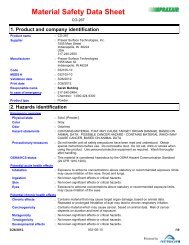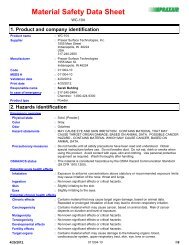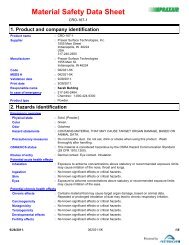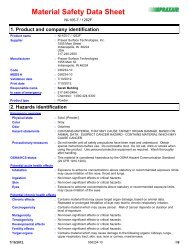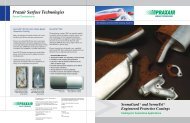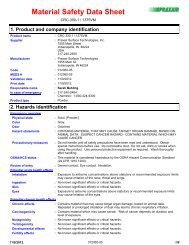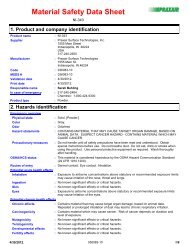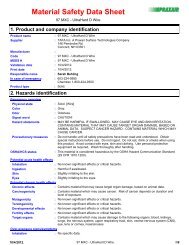NI-106 - Praxair Surface Technologies
NI-106 - Praxair Surface Technologies
NI-106 - Praxair Surface Technologies
You also want an ePaper? Increase the reach of your titles
YUMPU automatically turns print PDFs into web optimized ePapers that Google loves.
<strong>NI</strong>-<strong>106</strong>8. Exposure controls/personal protectionTWA: 1 mg/m³, (as Ni) 8 hour(s).OSHA PEL 1989 (United States, 3/1989). Notes: as NiTWA: 1 mg/m³, (as Ni) 8 hour(s).ChromiumACGIH TLV (United States, 2/2010). Notes: measured as CrTWA: 0.5 mg/m³, (measured as Cr) 8 hour(s). Form: Inorganic<strong>NI</strong>OSH REL (United States, 6/2009). Notes: See Appendix C -Supplemental Exposure LimitsTWA: 0.5 mg/m³ 10 hour(s).OSHA PEL (United States, 6/2010). Notes: as CrTWA: 1 mg/m³, (as Cr) 8 hour(s).OSHA PEL 1989 (United States, 3/1989).TWA: 1 mg/m³ 8 hour(s).Recommended monitoringproceduresEngineering measuresHygiene measuresPersonal protectionRespiratoryHands :EyesSkinEnvironmental exposurecontrols9. Physical and chemical propertiesPhysical stateColorOdorDistributionMelting/freezing point :VOC content :Solubility: If this product contains ingredients with exposure limits, personal, workplace atmosphereor biological monitoring may be required to determine the effectiveness of the ventilationor other control measures and/or the necessity to use respiratory protective equipment.: Use only with adequate ventilation. If user operations generate dust, fumes, gas, vaporor mist, use process enclosures, local exhaust ventilation or other engineering controlsto keep worker exposure to airborne contaminants below any recommended or statutorylimits.: Wash hands, forearms and face thoroughly after handling chemical products, beforeeating, smoking and using the lavatory and at the end of the working period. Appropriatetechniques should be used to remove potentially contaminated clothing. Washcontaminated clothing before reusing. Ensure that eyewash stations and safety showersare close to the workstation location.:::Use a properly fitted, air-purifying or air-fed respirator complying with an approvedstandard if a risk assessment indicates this is necessary. Respirator selection must bebased on known or anticipated exposure levels, the hazards of the product and the safeworking limits of the selected respirator.Chemical-resistant, impervious gloves complying with an approved standard should beworn at all times when handling chemical products.Safety eyewear complying with an approved standard should be used when a riskassessment indicates this is necessary to avoid exposure to liquid splashes, mists ordusts. If operating conditions cause high dust concentrations to be produced, use dustgoggles.Personal protective equipment for the body should be selected based on the task beingperformed and the risks involved and should be approved by a specialist before handlingthis product.: Emissions from ventilation or work process equipment should be checked to ensure theycomply with the requirements of environmental protection legislation. In some cases,fume scrubbers, filters or engineering modifications to the process equipment will benecessary to reduce emissions to acceptable levels.: Solid. [Powder.]: Gray.: Odorless: -90/+5u:1455 to 1900°C (2651 to 3452°F)0 lbs/gal (0 g/l)Insoluble in the following materials: cold water and hot water.4/25/2012.036006-054/8



